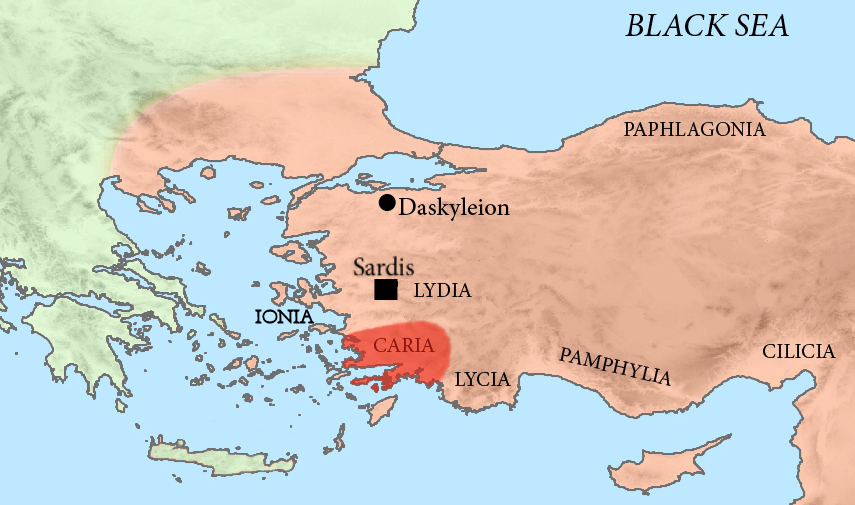Lygdamis II of Halicarnassus on:
[Wikipedia]
[Google]
[Amazon]
 Lygdamis II ( gr, ╬øŽŹ╬│╬┤╬▒╬╝╬╣Žé) (ruled c.460-454 BCE) was a
Lygdamis II ( gr, ╬øŽŹ╬│╬┤╬▒╬╝╬╣Žé) (ruled c.460-454 BCE) was a
 Lygdamis II ( gr, ╬øŽŹ╬│╬┤╬▒╬╝╬╣Žé) (ruled c.460-454 BCE) was a
Lygdamis II ( gr, ╬øŽŹ╬│╬┤╬▒╬╝╬╣Žé) (ruled c.460-454 BCE) was a tyrant
A tyrant (), in the modern English usage of the word, is an absolute ruler who is unrestrained by law, or one who has usurped a legitimate ruler's sovereignty. Often portrayed as cruel, tyrants may defend their positions by resorting to re ...
of Caria
Caria (; from Greek: ╬Ü╬▒Žü╬»╬▒, ''Karia''; tr, Karya) was a region of western Anatolia extending along the coast from mid- Ionia (Mycale) south to Lycia and east to Phrygia. The Ionian and Dorian Greeks colonized the west of it and joined ...
during the 5th century BCE, under the Achaemenid Empire. His capital was in Halicarnassus
Halicarnassus (; grc, ß╝ē╬╗╬╣╬║╬▒Žü╬Įߊ▒ŽāŽāŽīŽé ''Halikarn─üss├│s'' or ''Alikarn─üss├│s''; tr, Halikarnas; Carian: ÉŖĀÉŖŻÉŖ½ÉŖ░ ÉŖ┤ÉŖĀÉŖźÉŖĄÉŖ½ÉŖ░ ''alos k╠éarnos'') was an ancient Greek city in Caria, in Anatolia. It was located i ...
. He was the grandson of Artemisia, and son of Pisindelis, the previous tyrant.
Lygdamis assassinated the poet Panyassis
Panyassis of Halicarnassus, sometimes known as Panyasis ( grc, ╬Ā╬▒╬ĮŽŹ╬▒Žā╬╣Žé), was a 5th-century BC Greek epic poet from Halicarnassus in the Persian Empire (modern-day Bodrum, Turkey).
Life
Panyassis was the son of Polyarchus ( grc, ╬Ā╬┐╬ ...
, uncle of famous historian Herodotus
Herodotus ( ; grc, , }; BC) was an ancient Greek historian and geographer
A geographer is a physical scientist, social scientist or humanist whose area of study is geography, the study of Earth's natural environment and human society ...
, in 461, which forced Herodotus to leave his native city of Halicarnassus, fleeing to the island of Samos
Samos (, also ; el, ╬Ż╬¼╬╝╬┐Žé ) is a Greece, Greek island in the eastern Aegean Sea, south of Chios, north of Patmos and the Dodecanese, and off the coast of western Turkey, from which it is separated by the -wide Mycale Strait. It is also a se ...
.
After the death of Lygdamis, circa 454 BCE, Halicarnassus joined the Athenian alliance, known as the Delian League. At that time, Halicarnassus started to appear on the Athenian tribute quota lists.
From 395 BCE, Caria would again fall under the control of the Achaemenid Empire and be ruled by a new dynasty of local tyrants, the Hecatomnids
The Hecatomnid dynasty or Hecatomnids were the rulers of Caria and surrounding areas BCE.
The Hecatomnids were satraps (governors) under the Achaemenid Empire, although they ruled with considerable autonomy, and established a hereditary dynas ...
.
References
{{reflist Ancient Halicarnassians Lygdamid dynasty Achaemenid satraps of Caria 5th-century BC rulers in Asia 454 BC deaths